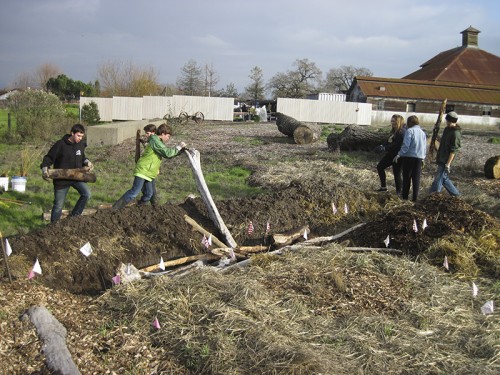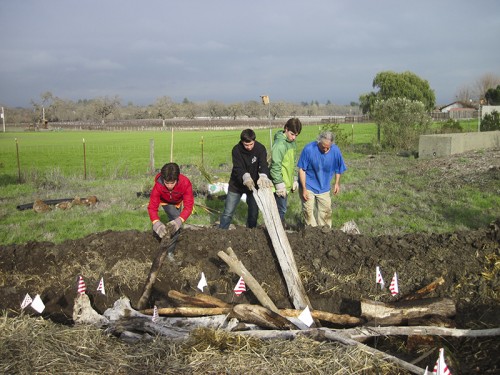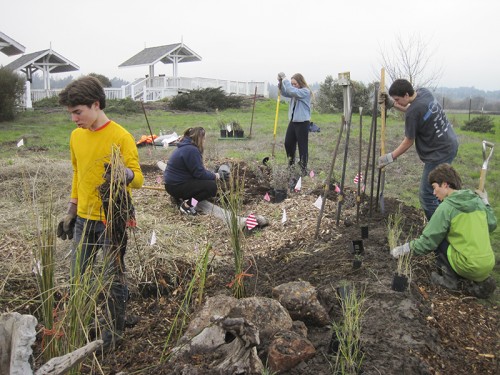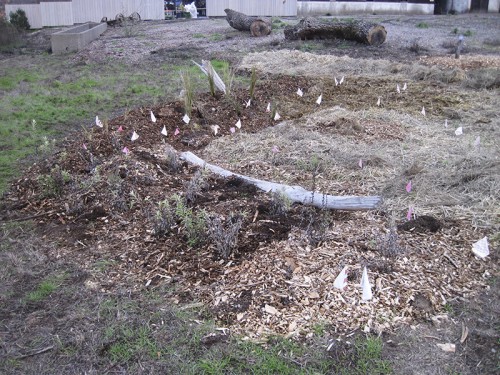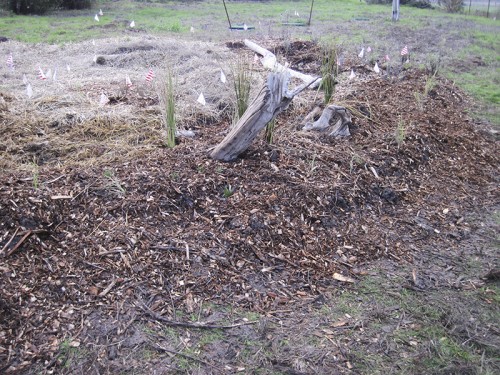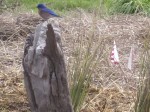
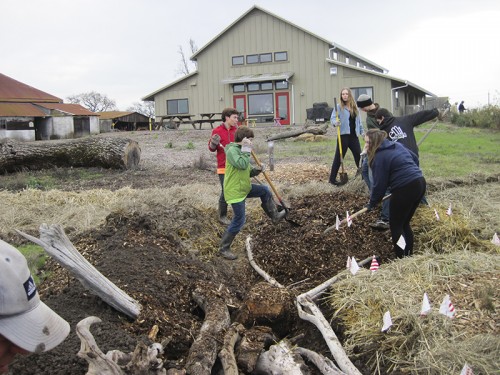 Amphibian Amphitheatre Ravine is a wildlife habitat landscaping project, an “installation”, that capitalizes on available moisture, on capturing pond overflow. This installation is another Outdoor Classroom monthly session with Orchard View School (Sebastopol, California) students and their teacher, Sunny Galbraith. Date completed: December 17, 2015.
Amphibian Amphitheatre Ravine is a wildlife habitat landscaping project, an “installation”, that capitalizes on available moisture, on capturing pond overflow. This installation is another Outdoor Classroom monthly session with Orchard View School (Sebastopol, California) students and their teacher, Sunny Galbraith. Date completed: December 17, 2015.
The Laguna de Santa Rosa Foundation operates the Laguna Environmental Center, or LEC, on Stone Farm, at 900 Sanford Road, Santa Rosa, California, 95401. This wildlife habitat installation is in an open grassy area behind Heron Hall and east of the pond, down slope from Science Station Shelf.
Prep (before students)
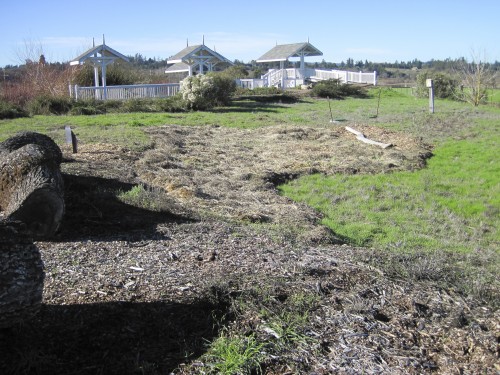 The Before. West view of Amphibian Amphitheatre (AA), a swatch of slope outlined by a down-slope berm. Amphibian Amphitheatre will contain many wildlife habitat installations. One installation, Amphibian Amphitheatre Hollow, installed last month, creates the north boundary of Amphibian Amphitheatre. Weeds had thrived in the shallow bowl of a slope, which is being kept moist by the pond overflow, and perhaps pond water weeping through the berm surrounding the pond. Those weeds and topsoil were scraped to create the down-slope berm of the Amphitheatre; since then, weeds are poking through the berm soil and mulch of dead weeds. Installing a new wildlife habitat, Amphibian Amphitheatre Ravine, will 1) provide a means to collect water in this already moist meadow, and 2) kill back weeds so that starts of native plants will thrive until established.
The Before. West view of Amphibian Amphitheatre (AA), a swatch of slope outlined by a down-slope berm. Amphibian Amphitheatre will contain many wildlife habitat installations. One installation, Amphibian Amphitheatre Hollow, installed last month, creates the north boundary of Amphibian Amphitheatre. Weeds had thrived in the shallow bowl of a slope, which is being kept moist by the pond overflow, and perhaps pond water weeping through the berm surrounding the pond. Those weeds and topsoil were scraped to create the down-slope berm of the Amphitheatre; since then, weeds are poking through the berm soil and mulch of dead weeds. Installing a new wildlife habitat, Amphibian Amphitheatre Ravine, will 1) provide a means to collect water in this already moist meadow, and 2) kill back weeds so that starts of native plants will thrive until established.
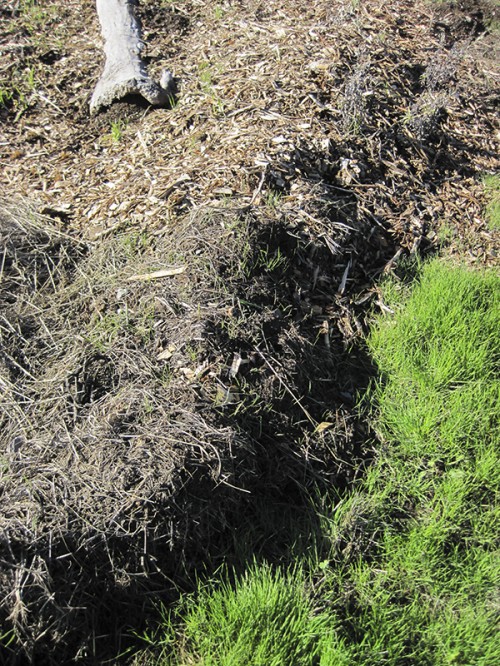 Weeds poking out of the berm down slope of Amphibian Amphitheatre (left).
Weeds poking out of the berm down slope of Amphibian Amphitheatre (left).
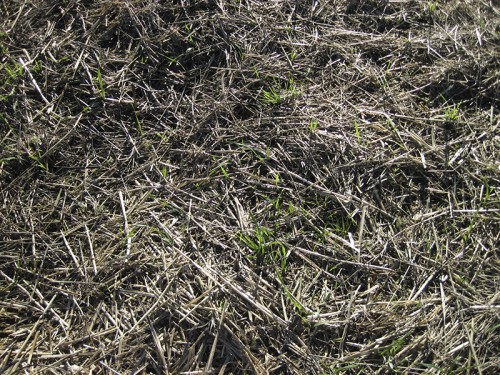 And more weeds in the center of Amphibian Amphitheatre. Straw mulch will be added on top of these weeds to kill them back.
And more weeds in the center of Amphibian Amphitheatre. Straw mulch will be added on top of these weeds to kill them back.
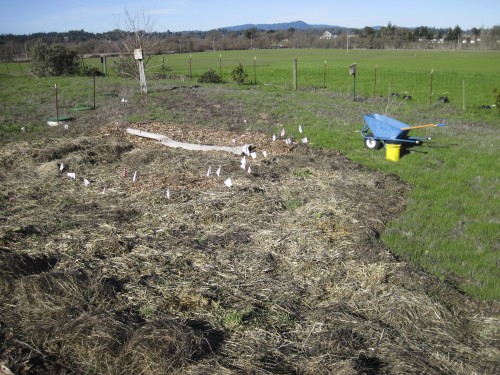 Irrigation flags outline where students can walk, or not. The north west corner of Amphibian Amphitheatre is off limits — we do not want to disturb last month’s work — a patch of juncus plants and Amphibian Amphitheatre Hollow.
Irrigation flags outline where students can walk, or not. The north west corner of Amphibian Amphitheatre is off limits — we do not want to disturb last month’s work — a patch of juncus plants and Amphibian Amphitheatre Hollow.
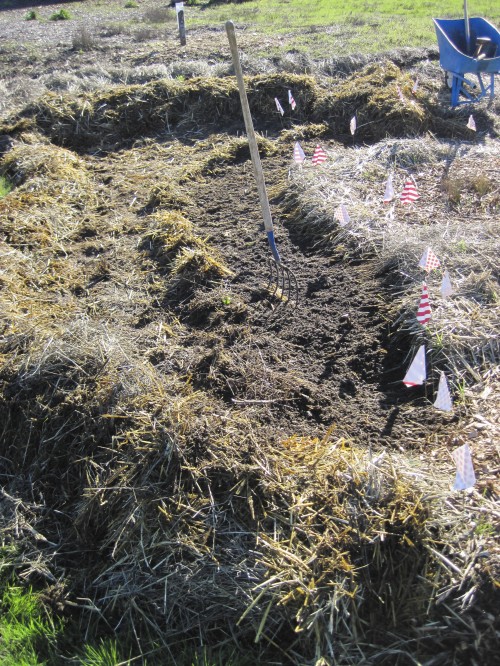 Straw mulch is scrapped away to reuse as mulch, that is, to remulch the area once the Ravine is dug and filled with wood. A hay fork was easy to use because it did not mix soil into the straw.
Straw mulch is scrapped away to reuse as mulch, that is, to remulch the area once the Ravine is dug and filled with wood. A hay fork was easy to use because it did not mix soil into the straw.
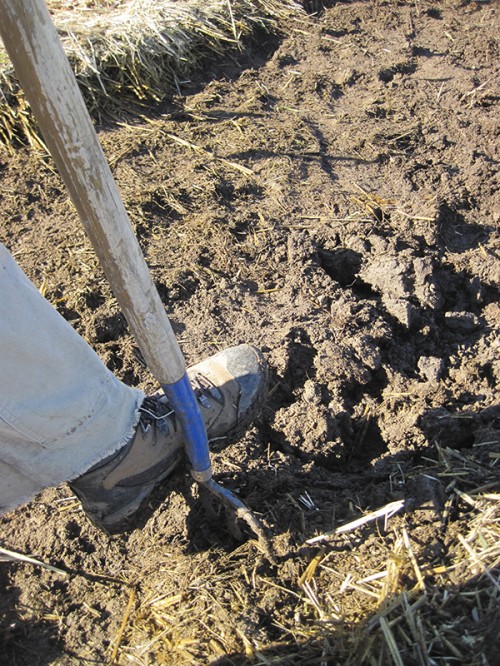 Using a hay fork to dig wet adobe soil. SOMETHING LEARNED! — I discovered how much easier digging the clinging, heavy adobe mud was with a fork instead of a shovel. When tossing a fork-load, the mud flew off the fork. So much easier than having to knock or pull mud off of a shovel.
Using a hay fork to dig wet adobe soil. SOMETHING LEARNED! — I discovered how much easier digging the clinging, heavy adobe mud was with a fork instead of a shovel. When tossing a fork-load, the mud flew off the fork. So much easier than having to knock or pull mud off of a shovel.
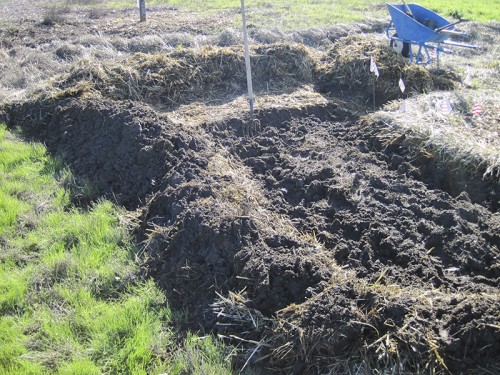 Inch by inch, slowly the hole crept (got deeper). Note the clean (little-soil) piles of straw (top of photo) and the berm’s fresh topsoil ridge.
Inch by inch, slowly the hole crept (got deeper). Note the clean (little-soil) piles of straw (top of photo) and the berm’s fresh topsoil ridge.
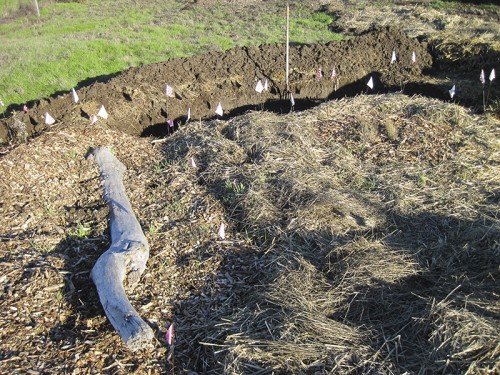 Progress for the work day. Note how high the berm is and the sun in the deep hole. Tomorrow, perhaps a little more digging, then the students will backfill the hole with wood and soil from the berm.
Progress for the work day. Note how high the berm is and the sun in the deep hole. Tomorrow, perhaps a little more digging, then the students will backfill the hole with wood and soil from the berm.
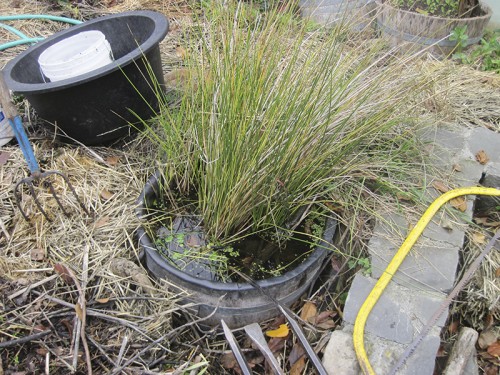 Tomorrow is here! Today is Amphibian Amphitheatre Ravine’s installation day. First job — collecting juncus patens from my (Tony’s) barrel ponds for transplant into the installation. Of all the tools shown in the photo, I wound up using only the bow saw.
Tomorrow is here! Today is Amphibian Amphitheatre Ravine’s installation day. First job — collecting juncus patens from my (Tony’s) barrel ponds for transplant into the installation. Of all the tools shown in the photo, I wound up using only the bow saw.
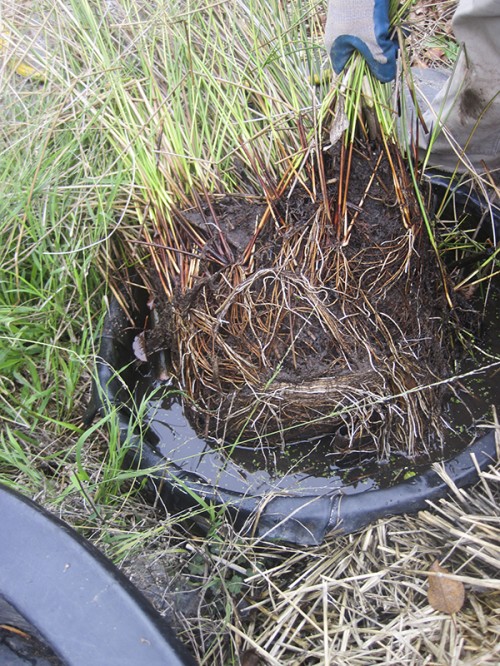 By the hair! Holding up enough plants to lift the root mass out of the water with one hand, while cutting through the root mass with the bow saw with the other hand.
By the hair! Holding up enough plants to lift the root mass out of the water with one hand, while cutting through the root mass with the bow saw with the other hand.
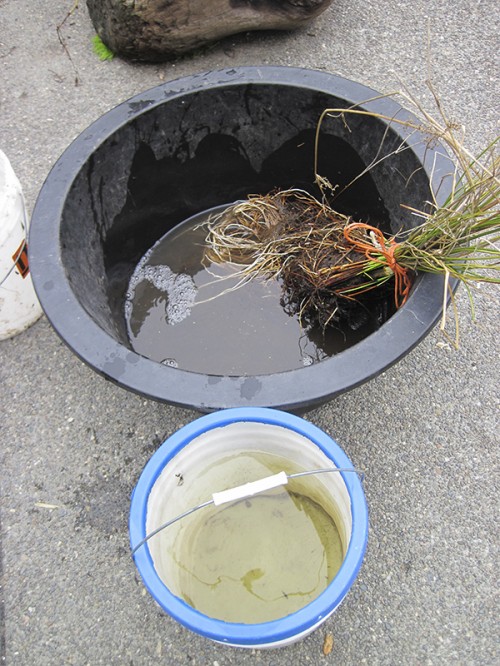 A bundle of juncus awaits transport to the LEC. Collected rainwater was used to keep the pond juncus thriving till transplanting.
A bundle of juncus awaits transport to the LEC. Collected rainwater was used to keep the pond juncus thriving till transplanting.
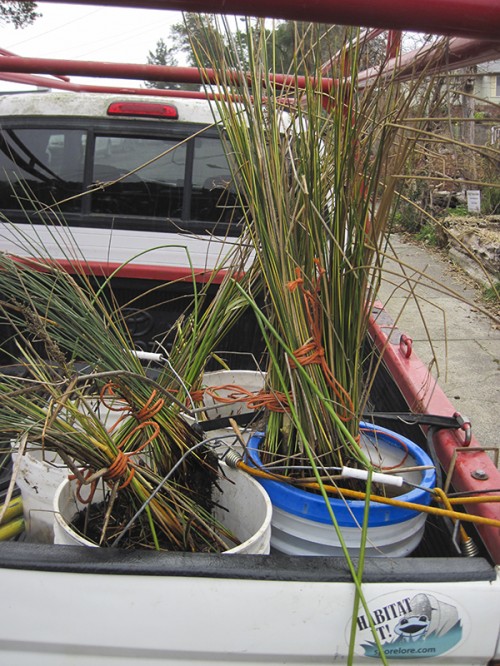 Juncus bunches ready for Amphibian Amphitheatre Ravine. Note the buckets full of water to ensure the roots are not exposed to the air.
Juncus bunches ready for Amphibian Amphitheatre Ravine. Note the buckets full of water to ensure the roots are not exposed to the air.
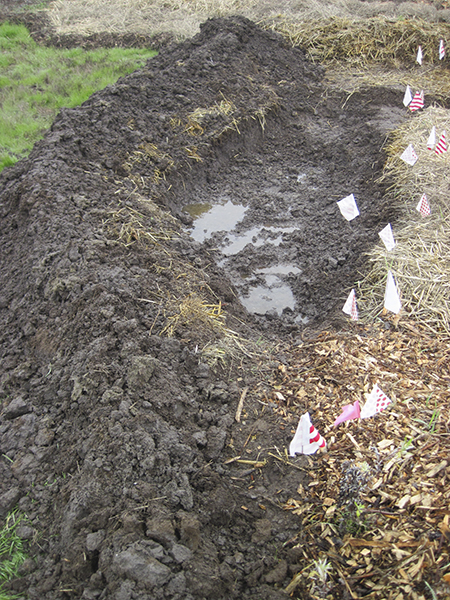 Installation Day, and we are starting with puddles of water in mud. Yuck! But such is exactly why we have chosen this sight as an amphibian wildlife habitat — available water. There was no rain last night at the LEC (CoCoRaHS says so for 12-16-2015, at rain gauge station Santa Rosa 6.7 WSW). This precious water either seeped through the Pond berm or collected from morning moisture draining down slope. Either way, the amphibians will love it, and breathe easier.
Installation Day, and we are starting with puddles of water in mud. Yuck! But such is exactly why we have chosen this sight as an amphibian wildlife habitat — available water. There was no rain last night at the LEC (CoCoRaHS says so for 12-16-2015, at rain gauge station Santa Rosa 6.7 WSW). This precious water either seeped through the Pond berm or collected from morning moisture draining down slope. Either way, the amphibians will love it, and breathe easier.
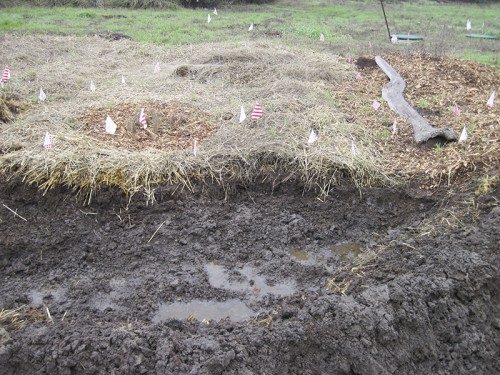 The start of prep day 2, view from over the berm (foreground).
The start of prep day 2, view from over the berm (foreground).
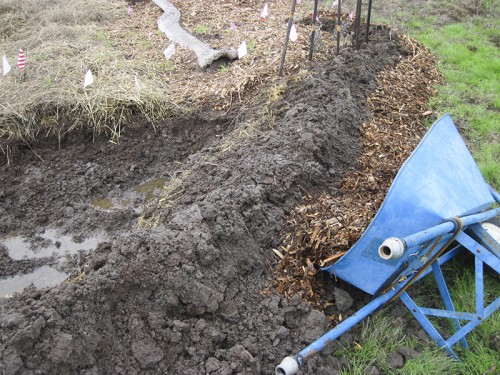 Woodchips dumped along the berm will 1) create a thick mulch to inhibit weeds along the berm’s edge, and 2) give the students a relative height when they skim off the top of the berm into the Ravine.
Woodchips dumped along the berm will 1) create a thick mulch to inhibit weeds along the berm’s edge, and 2) give the students a relative height when they skim off the top of the berm into the Ravine.
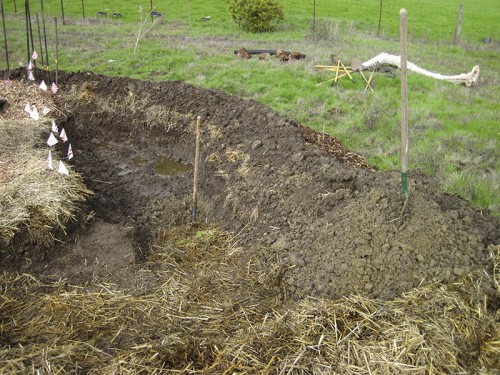 Deeper goes the Ravine. 1) Note how the hay fork (left) is in the deepest area of the Ravine. Digging was slow — the heavy wet clay was hard to get to. Therefore, a concentrated hole (versus the entire length of the berm) about 3 feet X 3 feet was dug as deep as possible. “Possible” was limited by the length of the hay fork and my not falling in the hole. Original vision: the entire length of the berm would be very deep. Reality: the 9 square foot hole attained a good depth, that is, deep enough for the students to anchor a bird perch in. 2) Note how high the berm is; much more soil than we want to be left on the finished, wannabe-natural-looking berm. Because the students will have little time to back fill the Ravine, keeping the dug-out soil close at hand will facilitate replacing that soil. 3) Note the higher, larger mud/soil pile to the right of the berm with the hay fork at its peak. The second hay fork was used to slam the digging hay fork into. Even on the hay fork, the wet mud from the deepest area of the Ravine wanted to stick to the fork; slamming one fork against the other helped clear the digging fork. 4) The large end pile of mud/soil has a 2-fold stategy — a) a depository for excess soil to be thrown back into the hole IF more soil is needed, or b) a landscaped hill, higher and wider than the berm, if the soil is not needed/used. A win-win pile of mud! 5) Tools, a tree limb, landscaping boulders, and a vent pipe await the students to arrive.
Deeper goes the Ravine. 1) Note how the hay fork (left) is in the deepest area of the Ravine. Digging was slow — the heavy wet clay was hard to get to. Therefore, a concentrated hole (versus the entire length of the berm) about 3 feet X 3 feet was dug as deep as possible. “Possible” was limited by the length of the hay fork and my not falling in the hole. Original vision: the entire length of the berm would be very deep. Reality: the 9 square foot hole attained a good depth, that is, deep enough for the students to anchor a bird perch in. 2) Note how high the berm is; much more soil than we want to be left on the finished, wannabe-natural-looking berm. Because the students will have little time to back fill the Ravine, keeping the dug-out soil close at hand will facilitate replacing that soil. 3) Note the higher, larger mud/soil pile to the right of the berm with the hay fork at its peak. The second hay fork was used to slam the digging hay fork into. Even on the hay fork, the wet mud from the deepest area of the Ravine wanted to stick to the fork; slamming one fork against the other helped clear the digging fork. 4) The large end pile of mud/soil has a 2-fold stategy — a) a depository for excess soil to be thrown back into the hole IF more soil is needed, or b) a landscaped hill, higher and wider than the berm, if the soil is not needed/used. A win-win pile of mud! 5) Tools, a tree limb, landscaping boulders, and a vent pipe await the students to arrive.
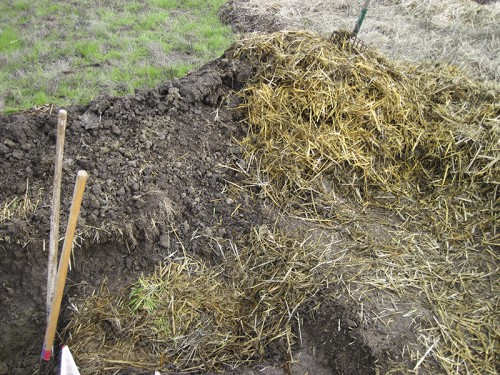 Straw to walk on lines the Ravine “steps” and holds the soil/mud pile together.
Straw to walk on lines the Ravine “steps” and holds the soil/mud pile together.
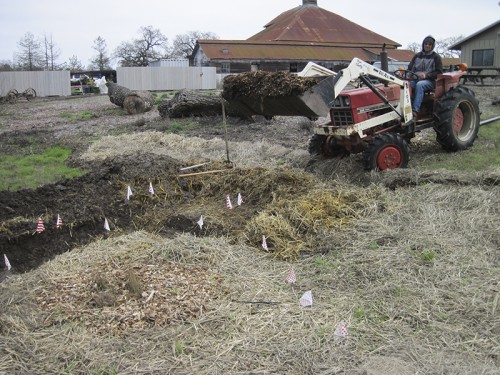 Here come the woodchips, to be dumped on the side lines, ready for the students to mulch the Ravine. Note that more mud was tossed on the large end-cap soil pile, on top of the straw layer. Digging is now complete, done, finished!
Here come the woodchips, to be dumped on the side lines, ready for the students to mulch the Ravine. Note that more mud was tossed on the large end-cap soil pile, on top of the straw layer. Digging is now complete, done, finished!
Students at work
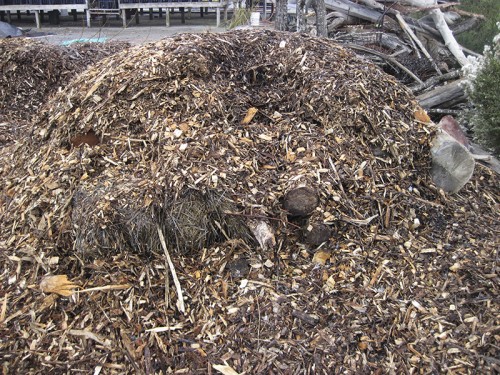 The LEC’s Woodchip Pile Annex — habitat installation logs, limbs, stumps, and rocks have been stored in the woodchips to promote soil-friendly resources. The Orchard View students have arrived and pull from the pile to fill Amphibian Amphitheatre Ravine with wood and rock.
The LEC’s Woodchip Pile Annex — habitat installation logs, limbs, stumps, and rocks have been stored in the woodchips to promote soil-friendly resources. The Orchard View students have arrived and pull from the pile to fill Amphibian Amphitheatre Ravine with wood and rock.
 Students determine how the Ravine’s floor is filled with wood logs and stumps, a collaborative effort.
Students determine how the Ravine’s floor is filled with wood logs and stumps, a collaborative effort.
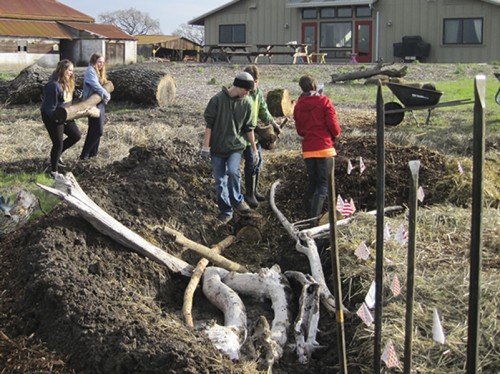 Bring on the wood! More homes for critters and more water-wicks for plants. Note the Bird Perch climbing up the berm to the left; it is deeply anchored in the bottom of the Ravine. Critters will seek its water wicking wood, deep in the cool cool clay.
Bring on the wood! More homes for critters and more water-wicks for plants. Note the Bird Perch climbing up the berm to the left; it is deeply anchored in the bottom of the Ravine. Critters will seek its water wicking wood, deep in the cool cool clay.
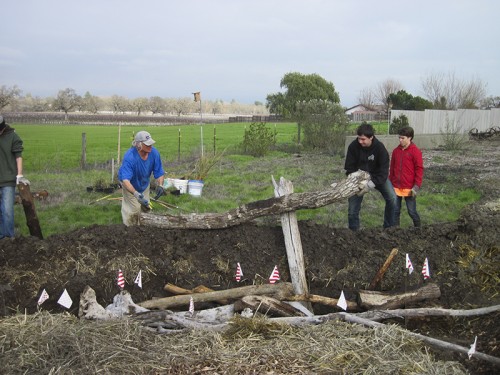 Using Bird Perch to slide a large log in place.
Using Bird Perch to slide a large log in place.
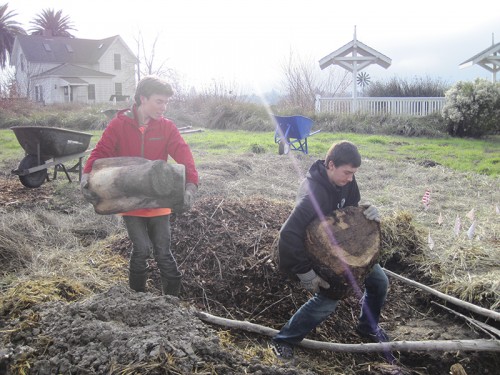 Large stumps in Ravine will soak up water and slowly wick it between morning fogs and seasonal rain.
Large stumps in Ravine will soak up water and slowly wick it between morning fogs and seasonal rain.
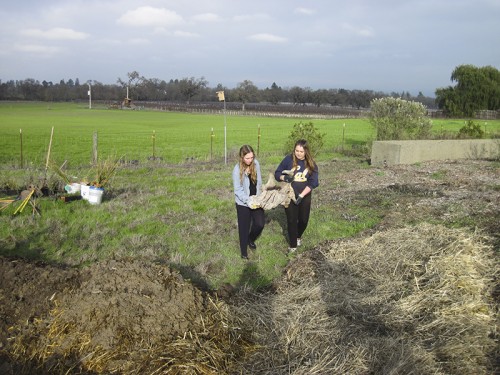 Redwood Burl Basin arrives. The dense redwood root burl has a shallow bowl, perfect for trapping water.
Redwood Burl Basin arrives. The dense redwood root burl has a shallow bowl, perfect for trapping water.
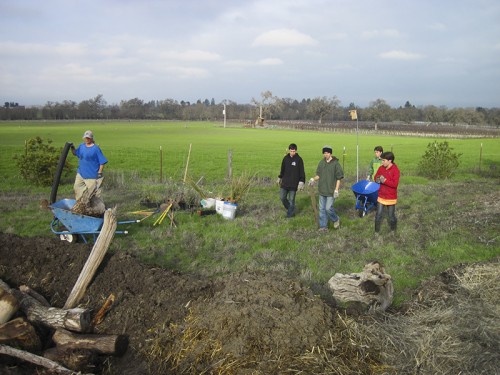 Tony pulls the vent pipe, a section of plastic 4″ corrugated drainpipe, into service.
Tony pulls the vent pipe, a section of plastic 4″ corrugated drainpipe, into service.
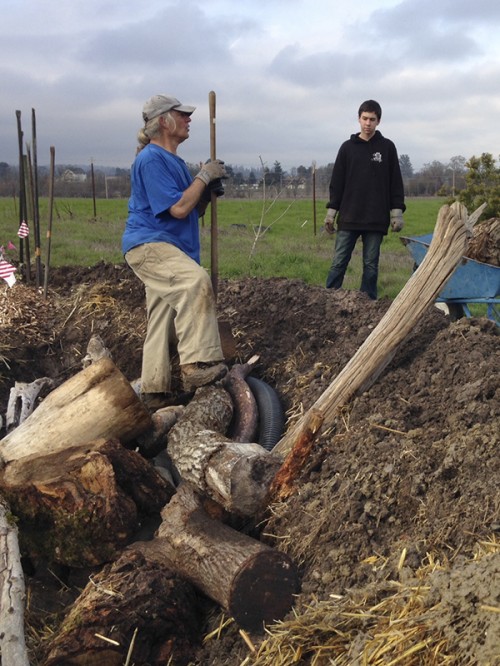 The bottom of the hole, at the base of Bird Perch, is vented up to the base of the berm, using the black plastic 4″ drainpipe. Nice muddy boot!
The bottom of the hole, at the base of Bird Perch, is vented up to the base of the berm, using the black plastic 4″ drainpipe. Nice muddy boot!
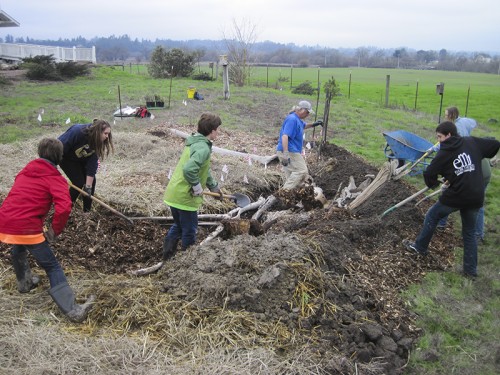 All wood logs, limbs, and stumps are in Ravine. Time to back fill — equal parts soil and woodchip. Note 3 students working skimming off the top of the berm soil. 2 students adding woodchips. 1 student leveling off the large soil pile.
All wood logs, limbs, and stumps are in Ravine. Time to back fill — equal parts soil and woodchip. Note 3 students working skimming off the top of the berm soil. 2 students adding woodchips. 1 student leveling off the large soil pile.
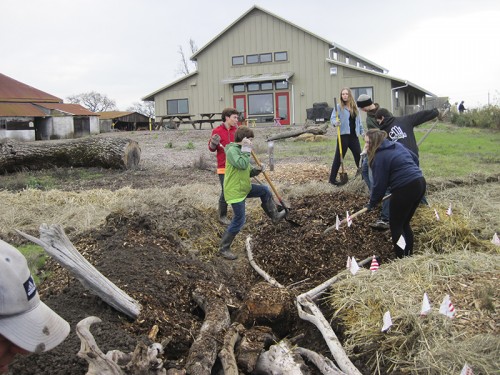 Fill, fill, fill. There will be plenty of nooks and crannies for critters under the fill.
Fill, fill, fill. There will be plenty of nooks and crannies for critters under the fill.
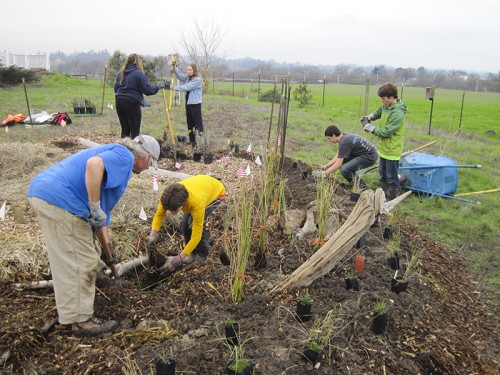 Dressing up Amphibian Amphitheatre Ravine with plants — pick a partner! FRONT LEFT — water-loving juncus between logs and below the berm. Juncus can be periodically flooded; therefore, it is classified as a semi-emergent species. RIGHT — wild creeping rye (leymus triticoides) on the berm. BACK LEFT — more mugwort (Artemisia douglasiana) is planted along Amphibian Amphitheatre Hollow.
Dressing up Amphibian Amphitheatre Ravine with plants — pick a partner! FRONT LEFT — water-loving juncus between logs and below the berm. Juncus can be periodically flooded; therefore, it is classified as a semi-emergent species. RIGHT — wild creeping rye (leymus triticoides) on the berm. BACK LEFT — more mugwort (Artemisia douglasiana) is planted along Amphibian Amphitheatre Hollow.
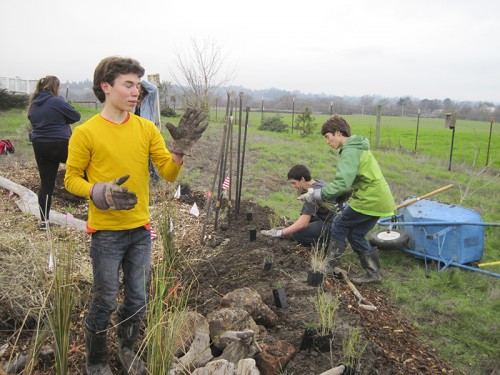 Not only does this student have five fingers on his left hand, but also Sonoma fieldstone boulders have been grouped around Redwood Burl Basin, which covers the vent pipe.
Not only does this student have five fingers on his left hand, but also Sonoma fieldstone boulders have been grouped around Redwood Burl Basin, which covers the vent pipe.
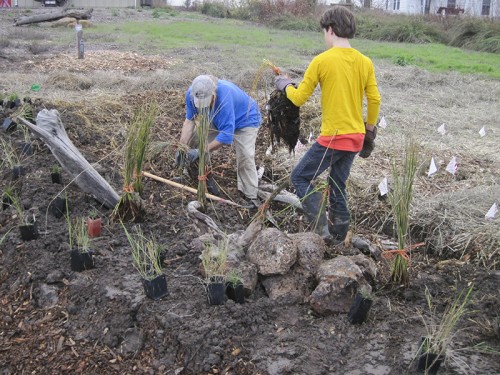 Dripping wet juncus is planted deep. In foreground, a line of rye plants are ready for planting.
Dripping wet juncus is planted deep. In foreground, a line of rye plants are ready for planting.
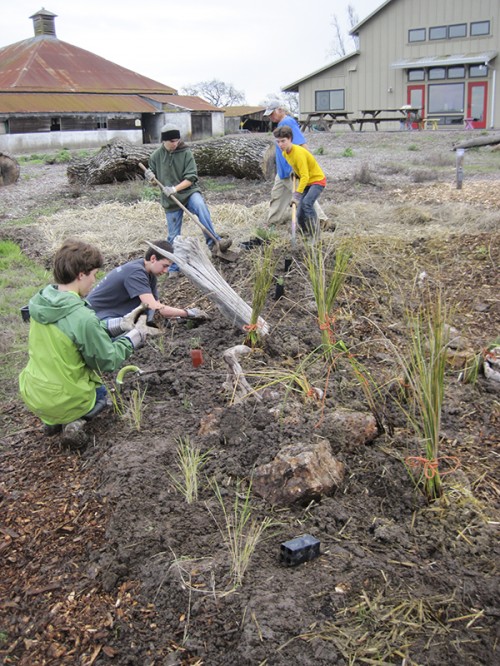 The large soil pile at the end of the berm has been used to fill in Ravine; the berm and pile are level.
The large soil pile at the end of the berm has been used to fill in Ravine; the berm and pile are level.
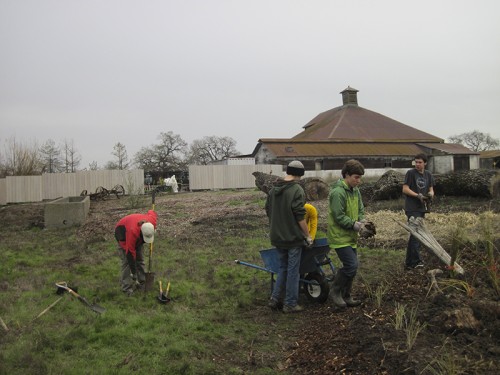 Woodchip mulching around the new plantings AND cleanup. Amphibian Amphitheatre Ravine wildlife habitat installation is in!
Woodchip mulching around the new plantings AND cleanup. Amphibian Amphitheatre Ravine wildlife habitat installation is in!
 West view, looking out to the Pond Bridge and Observation Platform.
West view, looking out to the Pond Bridge and Observation Platform.
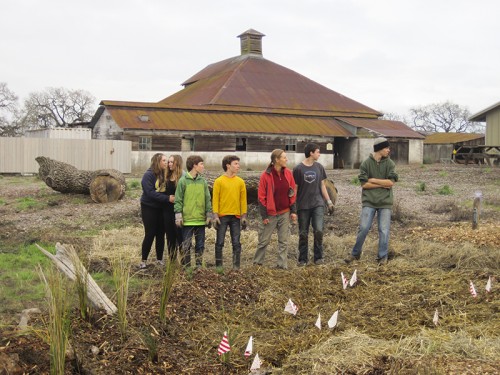 Nice job, Orchard View! Orchard View students and teacher Sunny Galbraith scan the Laguna Environmental Center — where will next month’s wildlife habitat installation be?
Nice job, Orchard View! Orchard View students and teacher Sunny Galbraith scan the Laguna Environmental Center — where will next month’s wildlife habitat installation be?
Final Touches (after students)
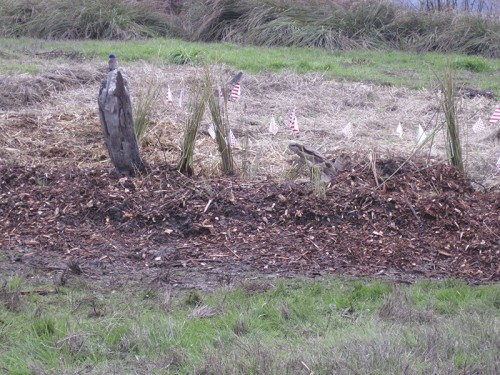 An hour after the students left, I caught this blue bird on Bird Perch as the sun set.
An hour after the students left, I caught this blue bird on Bird Perch as the sun set.
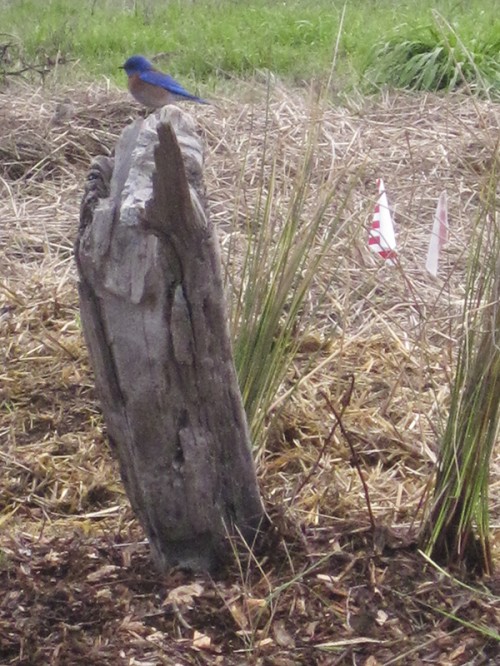 And the blue bird said, “Habitat it!”
And the blue bird said, “Habitat it!”
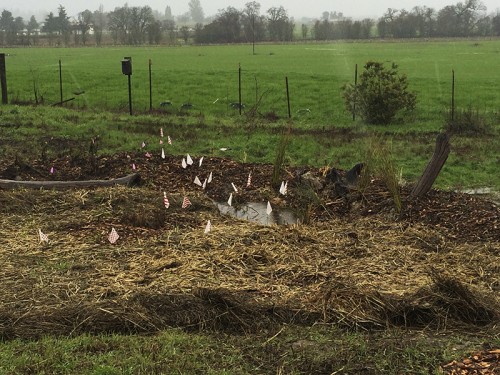 Just a few days after installation, Amphibian Amphitheatre Ravine collects rainwater. Note the pooled water up against the juncus-planted berm. Water also pools on the other side of the berm, showing how low this area is.
Just a few days after installation, Amphibian Amphitheatre Ravine collects rainwater. Note the pooled water up against the juncus-planted berm. Water also pools on the other side of the berm, showing how low this area is.
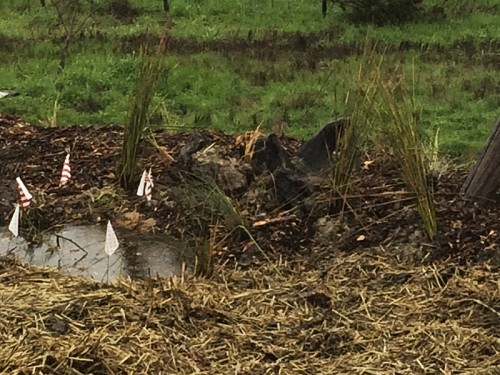 Close-up of Amphibian Amphitheatre Ravine Lake. Happy plants, happy soaking logs and stumps!
Close-up of Amphibian Amphitheatre Ravine Lake. Happy plants, happy soaking logs and stumps!
Much appreciation to the Laguna Foundation’s Restoration and Conservation Science Program staff Wendy Trowbridge (Director), Brent Reed (Manager), Aaron Nunez (Tech II), and Paul Weber (Tech). And thank you, the Laguna Foundation staff in general, for welcoming and nurturing this Outdoor Classroom over the years.
Thank you farmer Stuart Schroeder of Stone Farm for the tractor work.
Enjoy your outdoor classrooms and wildlife habitat gardening.
Tony

